|

Body piercing,
tattooing,
painting
in the galleries
of the
Penn Museum.
|
Tattooing
is probably the most popular form of body adornment in America
today. The designs can be small and discreet or large and obvious.
Many people prefer discreet designs that can be concealed for
certain occasions.
Tattooing
has actually been practiced since the time of the ancient Egyptians
and is common throughout the world.
The
Museum's Polynesian
gallery contains several examples of tattooing, including
this drawing (right) of an 19th century
Marquesan chief, with tattoos on his face, torso, and limbs.
Incidentally, the word "tattoo" is of Polynesian origin, related
to the Tahitian word tatau and the Marquesan word ta-tu.
|
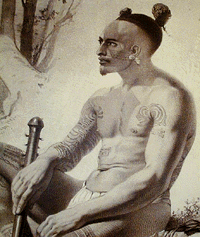
tattooed chief
at Taiohae, Nukuhiva
drawing, 19th century
|
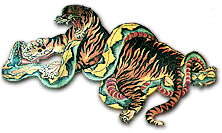
|
“In
all ages, far back into prehistory, we find human
beings have painted and adorned themselves...”
--H.G.
Wells
|
|
|
In the Samoan
Islands men were traditionally tattooed from waist to knees.
A drawing (right) in the Museum's Polynesia gallery shows an
example of a Samoan tattooing pattern for men. Women were also
tattooed on their thighs and knees, but with delicate, repeated
individual motifs. Samoan boys were tattooed at the age of 16-18
years, in a group puberty ceremony that served to reinforce
societal authority. In battle, tattos were thought to confer
magical protection. Execution of a design like the one shown
in the sketched example typically took a month to six weeks.
A special tattooing shed was built and was burned when the process
was completed.
|
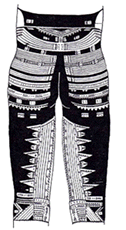
(Above) Sketched example of a Samoan tattooing
pattern on the back of a man's body
|

|
Samoan tattoo
artists used combs like the one in the Museum's Polynesian gallery
(left) to apply the design. They would
dip the comb in a mixture of water and candlenut soot and then
tap the comb with a stick, causing the pointed teeth to puncture
the skin.
Tattooing
comb, au songi aso tetele.
The plate of the comb is made of bone and turtle shell.
Samoan
Islands, 19th century
|
|
While Samoan
men covered their lower bodies with tattoos, Maori men of
New Zealand covered their buttocks, thighs, and faces. Maori
men had their faces tattooed by an artist of "moko," a
technique unique to the Maori. The pattern was literally carved
into the skin with a chisel, much the way designs are carved
into wood. Ink would be placed in the cuts to create the tattoo.
The process, which was extremely painful, was typically done
in stages, starting in early adulthood. Maori facial tattoos
were indications of power and prestige, designed to impress
and intimidate, especially in battle. Since no two patterns
were alike, men's facial tattoos were also markers of individual
identity. |
|
As you may
imagine, this procedure was incredibly painful, and it caused
a lot of swelling in the face. In fact, so much swelling occurred
that the man could not eat normally. Funnel-like feeding tubes
were made to allow the man to be nourished with liquid food.
While this may seem like a lot to go through for a tattoo, it
isn't a far stretch from what some American teenagers have to
endure. Tongue piercing is
increasing in popularity, but the procedure causes the tongue
to swell. Solid food can't be eaten for several days after a
tongue piercing, and a popular alternative is to eat baby food
instead.
Tattooing
of Maori women was limited to the lips and chin. Unlike the
facial tattoos of Maori men, facial tattoos of Maori women were
executed with a toothed comb.
|
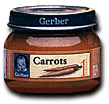
Sometimes the only alternative after facial
tattooing or tongue piercing is to eat baby food...
|
“And
who is so barbarous as not to understand that the foot
of a man is nobler than his shoe, and his skin nobler
than that of the sheep with which he is clothed?”
--Michelangelo
|
|
|
Native
Americans in Alaska also tattooed their chins. This mask
of the "Blueberry Woman" hanging in the Museum's Native
Alaskan gallery is a good example of tattooing on the chin
of a woman. Women throughout Africa have also occasionally tattooed
their faces. Even more prevalent throughout Africa than tattooing
is the tradition of scarification. Scarification is similar
to tattooing because dye is sometimes used. When dye is used
in the scarification process, it appears as if the woman has
a raised tattoo because scarification creates a raised pattern
on the skin.
|
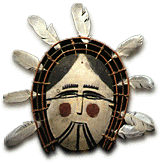
Wooden mask
of the "Blueberry Woman" (note tattooed
chin), Alaska,
1917
|
|

|
This figure
(left) from the Museum's African
gallery shows scarification patterns on its face and neck.
To receive scarification is a long and painful process that
African girls go through when they reach puberty. Once a girl
reaches puberty, she is also ready to be married. Scarification
patterns can assist her by making her more attractive to men,
who consider the patterns beautiful to look at and to touch.
The patterns are also regarded as testimony that the woman will
be able to endure the pains of childbirth.
African carving
of a female figure with
scarification
patterns on face and neck,
Zaire,
19th century
|
|
At a
tattoo parlor in America, the application of a simple design
usually takes at least an hour, but of course this can vary,
depending on the size and intricacy of the design. People's
relationships with their tattoos vary, and they attach different
meanings to tattooing. For some people, one design on one spot
of their body is meaningful. For others, tattooing can be a
process that takes years, and the tattoos, which cover most
of their body, become a kind of living "work in progress" or
record of their life. Still others opt for temporary tattoos
like these (right), available in the Museum Pyramid Shop.
|
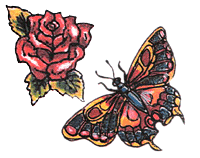
Temporary tattoos--for the more faint of heart!
Applied and removed with water, they're popular among children
and young adults.
|
|
